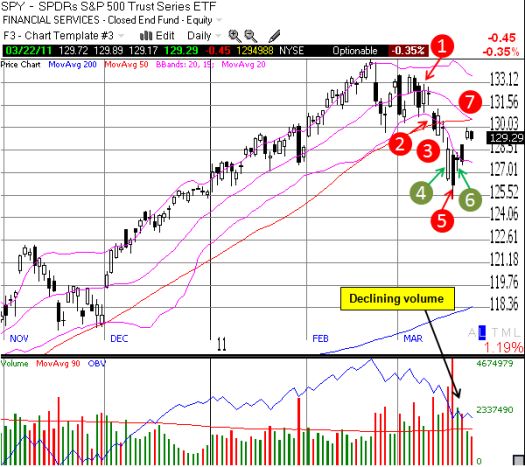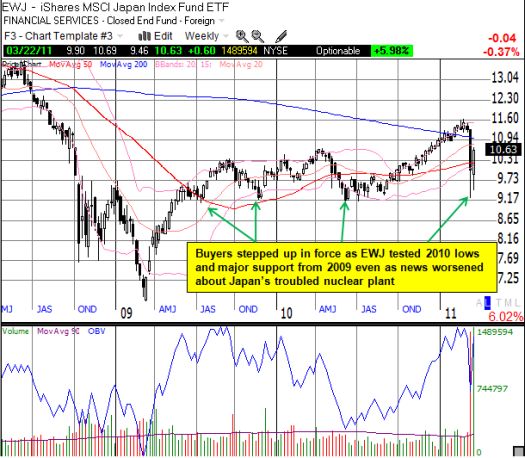One of the many interesting features of the stock market since it broke down on March 10th is that the news has often been a distraction to underlying developments in the market. Following the charts has been relatively more effective than following the news in creating a (short-term) trading strategy. T2108, the percentage of stocks trading above their respective 40-day moving averages (DMAs) has been particularly effective as an oscillator for flagging the risk/reward of shorts and buys.
The extreme uncertainties involved with the possible outcomes from the crisis in Japan along with on-going drama in the Middle East and North Africa will understandably trigger emotional and/or “move before thinking” reactions, but these moves tend to get reversed before a new consensus arrives on how to “properly” interpret the news. Moreover, the stock market has now recovered from several gut-wrenching episodes of fear since the March, 2009 lows and the lesson learned for more and more traders and investors is that these episodes are times to put cash to work. Under such conditions, the news will matter a lot less than the price action: while bears extrapolate that a catalyst has finally arrived to send the market where it “should be”, equally determined optimists will look over the horizon and ponder the positive “what-ifs.” And so volatility is born, sharp moves up and down, push and pull as bears and bulls trade being right and wrong.
The chart below is a review of the key technical features of the S&P 500 over the past two weeks. It provides one reference for surmising that the market will not manage to punch through the overhead resistance at the 50DMA anytime soon (without a specific catalyst). I use SPY, the SPDRs S&P 500 Trust Series ETF, instead of the index because the chart of the index does not accurately depict some of the recent opens, especially the day of the large gap down. I label each critical juncture with a number and explain the significance in a list below the chart.

- March 8 (pre-quake): S&P 500 index experiences its first significant change in trend since the rally off the August lows: the 20DMA flattens out. This marks the first yellow/red flag on the rally since the November lows.
- March 10: The stock market gaps down as news of the quake in Japan reverberates around the globe. The S&P 500 closes below the 50DMA for the first time since the rally off the August lows.
- March 11 and 14: The market churns as bears and bulls tug and pull on the market. A recovery close above the 50DMA is followed by another gap down and close below the 50DMA. On the 11th I conclude that sellers have finally gained the advantage.
- March 15: The market gaps down well below the lower Bollinger Band, but buyers step in immediately. The gap is not closed but the previous day’s low is tested before sellers impose a weak close. Being wary of the day’s Federal Reserve meeting may have helped navigate the day, but ahead of trade I speculated as follows:
“T2108 hit fresh 3 1/2 month lows at 44%. The S&P 500 bounced from these levels in November and August, so it is not a time to aggressively short…even with the bearish news flow. Central banks are likely to stand united in supporting liquidity (and calm) in the financial markets. The current action is a great time for market makers to take out stops and force some rushed selling at the open with a gap down, only to buy everything back at a discount (if that has not already happened in the futures market and/or pre-market trading).”
In other words, this day was a classic washout day with several oversold indicators converging at once to make for a powerful (short-term) buying opportunity.
- March 16: The sellers demonstrated they remain in overall control of the market by pushing back all of the previous gap buying gains and then some. This was a particularly virulent day, but conditions became even more oversold than the previous selling day. Volume surged to its highest level of the correction, the index was well below the lower Bollinger Band again, and in addition, T2108 closed at 28%, a level that has served as an approximate bottom for previous corrections since the March, 2009 lows. Accordingly, on the T2108 Resource Page, I wrote the following:
“The S&P 500 erased all of its post gap gains from yesterday. Essentially, everyone who bought for a trade yesterday has exited (the rest are extremely stubborn!). Now, the rubber really hits the road for our technical discipline. T2108 closed at 28%, right around where I *think* the intraday low was the previous day. As a reminder, these levels have been “good enough” for flagging a bottom since the March, 2009 lows except for last summer’s swoon. Given we cannot predict the outcome for the global turmoil that is mainly responsible for roiling the markets, all standard cautions apply to any trade. However, my starting assumption is that in a bull market, oversold conditions increase the likelihood that the market has started to discount whatever ails it.”
The stock market has yet to look back from this close.
- March 17: The stock market gapped up and confirmed the (short-term) bottom. Sellers were also unable to hold the index at the intraday lows.
- March 18, 21-22: The stock market’s follow-through has been choppy and weak on buying volume. No surprise that the stock market stopped cold right below the 50DMA resistance even after the strong gap up on the 21st, especially with the 20DMA also converging ahead of a likely downturn in the 50DMA trendline.
At this point, I expect the the stock market will require a definitive, positive catalyst to overcome the resistance directly overhead. Buyers rushed into the market extremely quickly to snap up the “bargains” created by the crisis in Japan. For example, in the three trading days following the earthquake, almost $1B poured into the EWJ, the iShares MSCI Japan Index Fund ETF. The $692M on March 15th alone was a record. EWJ saw net inflows of about $1.3B for the year up until that point.

*All charts created using TeleChart:

This buying is going to give sellers who were too slow to unload earlier an opportunity to finally sell. Moreover, such ready enthusiasm to buy under these conditions “must” give way to several bouts of setbacks and disappointments. Once this punch and counter-punch ends, an oversold reading on T2108 (or “close enough” to it) could mark the best buying opportunity of this entire episode. (Note I still think the market will not reach overbought levels again for quite some time).
T2108 is now at 47% and rallied sharply 14 percentage points to 50% the day before. This means that a large group of stocks went from breakdown to recovery and/or breakout. Many bulls will no doubt chase those. Bears will still find opportunity amongst the stocks struggling to join the group of recovering stocks. In other words, bears and bulls will likely find ample trading opportunities until the market’s next direction reveals itself…and you probably will not need to interpret the news and/or attempt impossible forecasts of highly uncertain events to take advantage; do not over-commit, stay consistent with your themes and discipline, and remain wary of any and all initial reactions to volatile news events, whether good or bad.
(Late-breaking news – the Egyptian stock market finally re-opened after a two month hiatus but was greeted with a 10% sell-off. Circuit breakers halted trading, but I have to imagine bottom-fishers are once again getting ready to treat the news as noise and the horizon as gold. Watch EGPT…)
Be careful out there!
Full disclosure: long SSO puts
